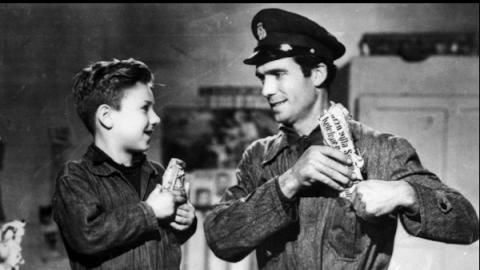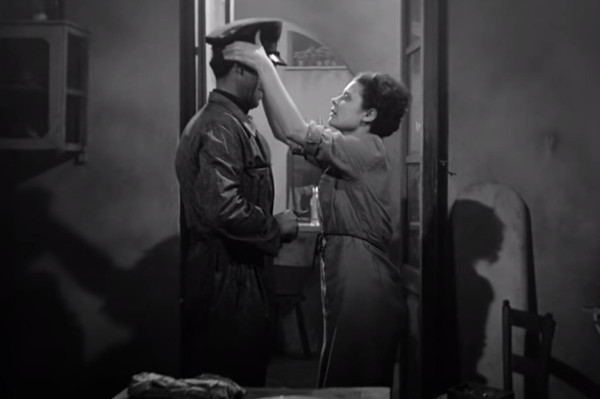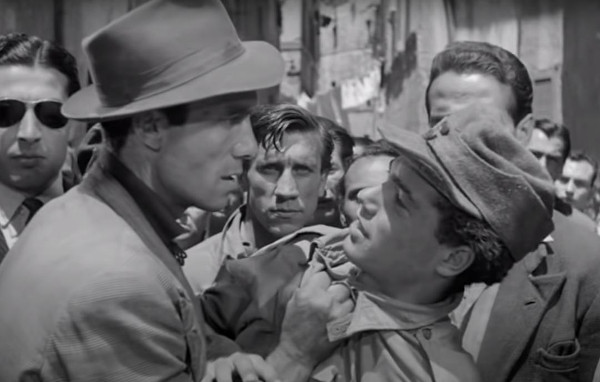Exploring the Symbolism of Hats in the Cinematic Masterpiece, ‘Bicycle Thieves’

Italian director Vittorio De Sica’s Bicycle Thieves follows Antonio Ricci’s quest for his stolen bicycle, his portal to employment, and consequent riches. Through documenting Antonio’s progress in hunting down the guilty Alfredo Catelli, De Sica also traces the evolution of Antonio’s hats.
De Sica implants three different styles––worn by Antonio as well as other characters––that work together to manifest a hierarchy where each style symbolizes a different level of authority. Likely, the most vulnerable style is no hat at all, sported by Antonio in moments such as presenting his bike to his boss on his first day of work.
Next, the fedora: It’s worn by Antonio throughout most of the film, and most consistently throughout the entirety of his active search to find his bike. Finally, a conductor hat is mostly worn by Antonio during moments of success or desperation for success, such as his first day on the job, or after a pep-talk and a dose of motivation from Baiocco to find the bike.
The position that women specifically take on in the world of Bicycle Thieves adds a gendered component to De Sica’s hat symbolism. There are a few instances in which women –– who are already sparse in the film –– contribute to the hat symbolism of the film: When Maria creates and presents Antonio’s conductor hat for his first day of work; when Antonio removes his hat for the female seer; and when women wear extravagant hats in church.

The film essentially utilizes hats as a component of mise-en-scène that establishes a symbolism-driven hierarchy of success; attention to the female role in the film’s hat culture reveals that women are integral for men's success.
Maria symbolizes the fact that women are also powerful when she tailors Antonio’s conductor hat herself and plants it onto his head, taking ownership of the hat’s symbolic success as the creator of its fit. Antonio’s first day of work entails a fedora, which he removes cordially upon meeting his boss. His boss then grants him a conductor's hat for his uniform, which Maria must tailor. Antonio says the hat requires “taking in” because it’s too big. Soon after, Maria finishes her modifications.
This moment of tailored-hat-completion begins with a hatless –– and symbolically powerless –– Antonio. Maria stands to place the fitted hat on him. This abrupt elevation from hat-free to a perfectly customized conductor hat indicates an equally abrupt transition from failure to optimum success. Such a sudden jump for Antonio to accomplish in his level of authority is suspicious, and that’s exactly why he loses his bike so quickly; it’s too good to be true.
Ultimately, Maria cannot do Antonio’s actual work, and even when she offers help, like selling her precious dowry to get Antonio’s bike in the first place, Antonio’s custom conductor hat is a false indicator of success because Maria is the reason the hat is tailored properly.

Church is the only place where men do not appear in headwear, but where most woman in the frame wear elaborate hats, which reaffirms the director’s idea of women’s power. After Antonio’s bike is stolen and he finds himself deep into his quest to locate the bike as well as its thief, he follows an old man whom he previously spotted with Alfredo.
Following the hierarchy of hats, all of the churchgoers sit free of any headwear, except for the women, who either wear headwraps or elaborate Panama hats with veils and floral embellishment. This contrast is emphasized by the stance of the women––their elevation––in a sea of hatless, seated men.
In a religious context, standing allows for connection and respect to God, making the strength of the hats more evident. This unanticipated moment where women, typically hatless, consistently wear flashy headwear in a space where men must go hat-free, insinuates female superiority, even above a higher force. In addition, Antonio doesn’t opt into the church service for the purpose of connecting to God, but it nonetheless makes sense that he’s there; he’s solving a problem that’s unfixable by anyone other than his wife.
The fight that transpires when Antonio finally locates Alfredo entails his felt conductor-esque hat falling off. The felt texture presents a sort of off-brandness to the success of a conductor hat that suggests Antonio’s eventual failure when attempting resolution without female assistance; the conductor hat belonging to the thief is not one constructed by Maria, and it therefore lacks value.
The throng of men observing the fight and eventually taunting Antonio symbolizes a man who’s supposedly in power, but who’s incapable of actually doing anything without his female counterpart. What’s more, physical fighting and its sensation is entirely opposite to the affection from Maria and approval from her. The fight opposes stereotypical concepts of womanhood and femininity as well. In essence, Antonio is trying desperately to redeem his bike, but with no trace of his female counterpart, he cannot do so.

In a post-war climate in Italy, the characters in Bicycle Thieves are depicted by De Sica as stressed and weighted with worry in regards to employment and income. The women aren’t expected to work -- there is little pressure placed onto them to handle sticky situations. However, per De Sica’s depiction of female strength and resourcefulness in the hat hierarchy, they should perhaps be responsible for coping with difficult situations because the director has shown us that they are capable.
This concept of women as being more proficient than society might expect is not a novel notion. Maria continuously encourages Antonio’s productivity – and is perhaps largely responsible for any success he may claim -- for the most part. And it is through the symbolism of the hat that Vittorio De Sica’s film advocates for the value and respect of womanhood.
Author Bio:
Eva Berezovsky is an undergraduate student at the University of Minnesota in Minneapolis. Studying Comparative Literature and Design, Eva is interested in writing, visual work, and the intersection of the two. Her creative portfolio can be viewed at www.evaberezovsky.com.
For Highbrow Magazine
Image Sources:
--Stevan Kragujevic (Wikipedia.org, Creative Commons)
--Produzioni De Sica






























































































































































































































































































































